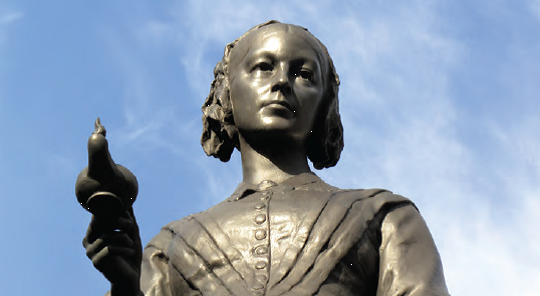When Florence Nightingale wrote her book Notes on Nursing: What It Is and What It Is Not, the purpose was to assist any woman in the practice of nursing in the home and elsewhere. Although it was not specifically a manual for nurses, it provided a vivid description of the enormous weight and responsibility for nurses during the Victorian period. In the Victorian era, medicine and nursing were described as distinctly different in their functions. A strong emphasis on providing a healthy environment for the ill person was central to the profession of nursing. Adequate ventilation, clean water, warmth, noise control, adequate light, and control of waste and odor needed to be attended to so that patient healing would be possible.1 The practice of medicine during this time period involved focusing on the cure of disease and repair of the injured. It is said that Nightingale supported genderization in health care roles: men in medicine and women in nursing.2
In the 1950s, the work of Hildegard Peplau highlighted the importance of nurse-patient communication and the significance of a therapeutic nurse-patient relationship. She believed that this relationship was central to all nursing activity with a patient. Establishing an environment conducive to developing trust, and working on a health issue then moving toward independence are important steps in providing nursing care.3
Fast forward to the professional life of Martha Rogers (1914-1994), and note that by this time understanding and treating the “irreducible whole” person had become the realm of nursing. Every human being was viewed as a Unitary Being. According to Martha Rogers, the profession of nursing focuses on people and the manifestations that emerge from a continuous mutual human and environmental process. The human being and the environment are “energy fields” and each field can be identified by pattern and observed by manifestations.4 Fine-tuning the observation skills of the professional nurse were of the utmost importance in this system.
Strongly influenced by Martha Rogers was Margaret Newman. Margaret Newman believed that the focus of nursing is not to correct what is wrong with the patient, but to attend to the process of health as expanding consciousness. This is a philosophy of “being with” as opposed to solely “doing for” the patient. Newman knew that people could be healthy in the midst of an illness because health and illness are manifestations of a greater whole. According to Newman, the nurse tends to the patient’s definition of health.5 This model is especially helpful when providing care to the dying patient and the patient with a progressive illness.
In the 21st century, today’s nurse is expected to know and incorporate all of what is known about nursing with the addition of some responsibilities that have been traditionally viewed as the practice of medicine. Nurses with advanced degrees are performing physical exams and writing prescriptions in numbers like never before. In the new health care environment, we can be sure that there will be greater numbers of people needing and requesting nursing services. Yet for the first time in years, new graduates are reporting difficulty finding their first job. The economy may have prevented the expected number of retirements in nursing, but it leaves young nurses to wonder about whether something larger is at work.
In the name of cost-effectiveness, nurses wonder if we will be delegating much of what nursing has traditionally been to technicians and nurse-extenders because these workers are less expensive than the professional nurse. Should we be moving further from the bedside into supervisory roles for technicians and nurse-extenders as many nurses move into roles that fill the void in the system for primary health providers?
Nurses have always been a good value for the dollar. With a broad level of knowledge and expertise, nurses have been prepared to step up to additional responsibilities in the provision of health care while retaining the valuable skills necessary in meeting the needs of the whole human being. We must be able to spend time with our patients, interacting directly and observing firsthand. A patient should never feel rushed or as if imposing on the nurse’s time. Nurses must practice fully with reasonable workloads and adequate staffing. There is no substitute for the nurse.
The future of nursing is bright as we continue our mission as patient advocates and health care activists and providers. We must never tire of making our voices heard and continue to provide feedback as a new system is shaped and refined. We must be active contributors every step of the way. We have an important contribution to make! MN
References
- Nightingale F. Notes on Nursing: What It Is and What It Is Not. New York: Dover Publications; 1969.
- Parker ME, Smith MC. Nursing Theories and Nursing Practice. 3rd Ed. Philadelphia: F.A. Davis Company; 2010.
- Peplau HF. Interpersonal relations: a theoretical framework for application in nursing practice. Nurs Sci Q. 1992 Spring;5(1):13-8.
- Malinski VM, Barrett, EA. Martha E. Rogers: Her Life and Her Work.
Philadelphia: F.A. Davis Company; 1994. - Newman MA. Transforming Presence: The Difference That Nursing Makes.
Philadelphia: F.A. Davis Company; 2008.
- Providing Cultural Competency Training for Your Nursing Staff - February 15, 2016
- Cultural Competence from the Patient’s Perspective - February 11, 2016
- Careers in Nephrology Nursing - February 10, 2016



